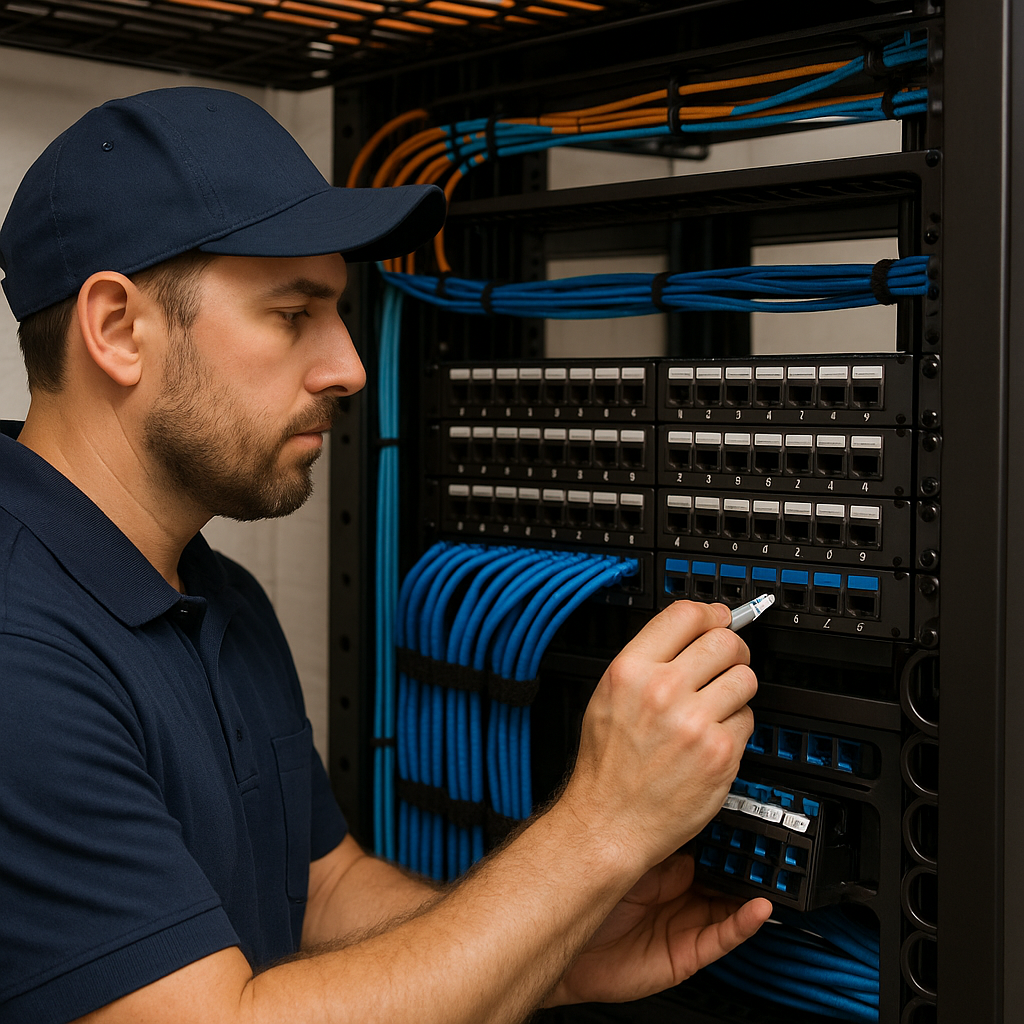Structured Cabling Performance Testing: A Guide for IT Leaders
Your school district or library has just invested in a network infrastructure upgrade. The new cabling installation is complete, and now the critical...
An unreliable network connection poses a direct threat to productivity, communication, and revenue. When data transmission slows to a crawl or connectivity drops without warning, the root cause is often hidden within the walls and ceilings: the structured cabling infrastructure. For IT managers and network technicians, pinpointing a faulty cable, connector, or patch panel in a complex system can feel like searching for a needle in a haystack.
This guide provides a systematic approach to troubleshooting common issues within your cabling system. We will move from simple visual inspections to using advanced diagnostic tools, helping you identify and resolve problems efficiently. Understanding the fundamentals of structured cabling is the first step, but knowing how to troubleshoot it ensures your network infrastructure remains a reliable asset rather than a constant liability.
Before investing in advanced testing equipment, a methodical, hands-on check can often reveal the source of a connectivity issue. This systematic process saves time and prevents unnecessary hardware replacement by focusing on the most likely and easily identifiable faults first. A logical approach is the most effective tool in your kit.
Start by physically examining the cable run, from the patch panel to the wall outlet. Look for obvious signs of physical damage, such as crushed or kinked jackets, exposed wiring, or cables stretched taut with no slack. Pay close attention to the connectors at both ends, ensuring they are securely seated and that the termination appears clean and correct, with no visible damage to the pins. Also, check the cable's path for sharp turns that violate its minimum bend radius—typically four times the cable's diameter—as this can cause signal degradation and data loss.
If a visual check reveals no obvious damage, your next step is to isolate the fault. Begin by swapping the patch cables at the user's desk and at the patch panel with known good cables to rule them out as the source of the problem. If the issue persists, try connecting the user's device to a different port on the switch that is known to be working. Documenting which components you've tested and cleared helps narrow down the problem to a specific horizontal cable run, wall jack, or patch panel port.
Many persistent and intermittent connectivity problems stem from a handful of recurring issues related to installation quality and the surrounding environment. Understanding these common culprits helps you diagnose network issues more accurately and implement lasting solutions. From invisible interference to microscopic termination faults, these factors can severely impact network performance.
Electromagnetic Interference is electronic noise generated by external sources like high-voltage power lines, large motors, or even fluorescent lighting fixtures. This interference can corrupt the data signals traveling through your copper cabling, leading to intermittent connections, slow transmission speeds, and high packet error rates. We recently traced a client's "ghost" connectivity drops to a bundle of Cat6 cables that ran parallel to a conduit for a new industrial machine for over 50 feet. To mitigate EMI, you should always route data cables at least 12 inches away from parallel power cables and consider using shielded twisted-pair (STP) cables in environments with heavy electrical equipment. Proper shielding and grounding techniques are critical for protecting signal integrity.
Crosstalk occurs when the signal from one twisted pair of wires bleeds over and interferes with the signal on an adjacent pair within the same cable. Near-End Crosstalk (NEXT) is measured at the transmitting end, while Far-End Crosstalk (FEXT) is measured at the receiving end. The primary causes are improper or inconsistent connector terminations, untwisting the pairs too much before termination, or using low-quality components that don't meet the cable's category rating. Re-terminating the connectors according to TIA T568A or T568B standards can often resolve crosstalk issues, but a professional cable certifier is the only way to accurately measure it and guarantee performance.
Attenuation, also known as insertion loss, is the natural weakening of a signal's strength as it travels the length of a cable. This signal degradation is a primary reason why Ethernet standards limit copper cable runs to 100 meters (328 feet). Exceeding this length, using low-quality cable, making too many connections along a single run, or having improper terminations can all increase attenuation to the point of failure. If you suspect a cable run is too long, a cable certifier can measure the insertion loss to confirm if it falls within acceptable parameters for its category.
Disorganized and improperly routed cables are not just a cosmetic issue; they are a direct cause of poor performance and future maintenance headaches. Using plastic zip ties pulled too tightly can compress the cable jacket, altering the geometry of the internal pairs and leading to signal degradation. Similarly, violating a cable's minimum bend radius puts physical stress on the copper conductors and can increase insertion loss. Best practices dictate using hook-and-loop straps, which can be secured without pressure, and respecting the cable's specified bend radius in all trays, racks, and pathways.
When visual inspections and basic swaps fail to identify the problem, specialized testing equipment provides definitive data on your cabling system’s health. These tools move you from guesswork to a precise diagnosis, saving hours of frustration and unnecessary work. Each tool serves a different purpose in the troubleshooting process.
Verification tools are the first line of defense for a technician. These handheld devices perform basic continuity tests to confirm that all pairs in the cable have a direct electrical path from one end to the other. They can quickly identify opens (a broken wire), shorts (wires touching each other), and incorrect wire mapping (mis-wirings like reversed or split pairs). A verifier is perfect for checking newly made patch cords or confirming a wall jack is wired correctly before connecting a device.
Qualification testers go a step beyond verification. They not only check the wiring but also test whether an existing cabling link can support specific network speeds and technologies, such as 1000BASE-T Gigabit Ethernet or Voice over IP (VoIP). This is particularly useful when you need to determine if an older, undocumented cabling infrastructure can handle a planned network speed upgrade. A qualifier gives you a clear "yes" or "no" on the cable's bandwidth capabilities.
Certification tools are the gold standard for testing and troubleshooting a cabling infrastructure. Devices like the Fluke Networks DSX CableAnalyzer perform a comprehensive suite of tests and measure a link’s performance against industry standards from organizations like the Telecommunications Industry Association (TIA). A certifier provides detailed PASS/FAIL reports on critical parameters like NEXT, insertion loss, and return loss, pinpointing the exact location of a fault along the cable's length. This level of in-depth cable testing is essential for validating new installations and solving the most elusive, intermittent network issues.
The most effective troubleshooting strategy is preventing problems before they start. A proactive approach to structured cabling maintenance ensures your infrastructure remains clean, organized, and reliable, minimizing unexpected downtime. Consistent upkeep protects your investment and supports your organization's evolving technological needs.
Schedule quarterly or semi-annual visual inspections of your telecommunication rooms, server racks, and patch panels. During these walkthroughs, look for cables that have become unplugged, strained, or damaged since the last check. Ensure labels remain clear and legible, as accurate labeling is crucial for efficient troubleshooting during an outage. This simple routine can help you catch minor problems before they escalate into major network issues.
Accurate, up-to-date documentation of your cabling system is one of your most valuable assets. This should include detailed diagrams of cable pathways, termination points, and port assignments, along with the results from the initial certification reports. As of October 2025, many organizations are using cloud-based infrastructure management platforms to keep this documentation live and accessible to the entire IT team. This repository is indispensable for planning future maintenance and upgrades and for quickly tracing faults during an emergency.
When installing or upgrading your network infrastructure, think beyond your immediate requirements. Installing a higher-category cable than you currently need, such as Cat6A instead of Cat6, can future-proof your system for next-generation applications and higher bandwidth demands. Additionally, best practices include leaving a "service loop" of extra cable in the ceiling or behind the rack and ensuring cable trays and conduits have spare capacity. This foresight makes future moves, adds, and changes far simpler and less disruptive to the entire network.
While many common cabling issues can be identified and resolved with in-house resources, certain situations require the expertise and advanced equipment of a professional. Knowing when to call in an expert can save your team significant time, prevent further damage, and resolve complex problems far more efficiently.
If you are facing connectivity problems that are intermittent or affecting multiple users across different parts of a building, it often points to a systemic issue. These "ghost" problems can be caused by complex factors like widespread EMI, grounding issues, or a fault in the backbone cabling. Professionals use high-end certifiers and time-domain reflectometers (TDR) to trace these elusive issues to their source, a task that is nearly impossible with basic tools.
Every new structured cabling installation or major upgrade should be professionally certified to guarantee that it meets industry performance standards. A certified installation provides a baseline performance report for every link, holding the installer accountable and giving you peace of mind. Without this third-party validation, you may be left with an underperforming system that will cause persistent network issues for years to come. Our Structured Cabling Installation services always include complete certification and documentation.
Professional-grade certification tools represent a significant capital investment and require trained technicians to interpret the results correctly. If your in-house team lacks the specific knowledge or equipment to diagnose a complex cabling issue, partnering with a specialist is the most cost-effective solution. A professional team brings the right tools and years of experience to solve the problem quickly and correctly the first time.
Don't let a faulty cabling infrastructure undermine your network's reliability. A systematic troubleshooting process can resolve many common issues, but persistent or widespread problems demand an expert eye. If you are tired of chasing intermittent connectivity issues, it’s time for a professional assessment.
Schedule onsite diagnostics with the experts at Turn-Key Technologies to pinpoint the root cause and restore your network performance. Explore our case studies to see how we've solved complex cabling challenges for businesses like yours, or get in touch to discuss your needs.

Kevin has been with Turn-key Technologies since 2012, overseeing cabling teams and managing projects from concept to completion. With deep expertise in structured cabling installations—including fiber optics, Cat5/5e/6/6a, and coax systems—he works closely with clients and engineers to deliver reliable, high-quality solutions on time and on budget.
Certifications:
NJ Division of Consumer Affairs
• Uniform & Construction Code
• Residential Fire Alarm Systems
• Smoke Detection Systems
• NJ Barrier Free Subcode
• ADA & Licensing Law
NYS Licenses
• Security & Fire Alarm License
• Electrical Training Center Fire Alarm Certification
BICSI & Technical
• Designing for PoE Lighting
• Fiber Optic & Connector Termination
• Firestop 101
Other Certifications
• OSHA 30-Hour Construction Safety
• Verkada Certified Engineer
• Avigilon Access Control Manager 6

Your school district or library has just invested in a network infrastructure upgrade. The new cabling installation is complete, and now the critical...

One bad decision during cabling installation can leave an entire building with unreliable network infrastructure for years. Cabling infrastructure...

4 min read
Your company is growing. You’re hiring new staff, adopting new technologies, and expanding your operational footprint. But can your network...